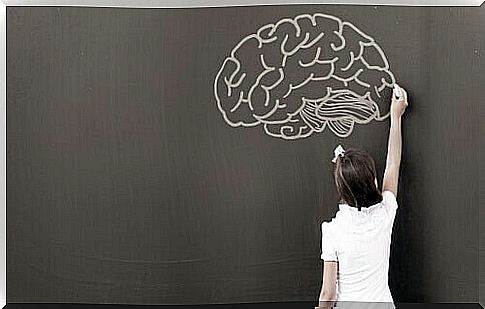WISC In Piscology: What Is It About?

As we all know, health professionals use a number of different tools to be able to evaluate each patient in the best way. In the case of psychologists, the most used method is that of standardized tests. One of the most famous and used tools in the case of children is the WISC .
Although it is a well-known and widely used method, not everyone knows how it is used or how it can help in clinical and educational settings. In today’s article we will try to explain what this test consists of and why it is used so much by psychologists.

What is the goal of the WISC?
The WISC is a test used to assess infant cognitive functioning. In specific terms, it serves to assess brain activity in specific areas such as memory, attention, processing speed, language and executive functions. These are fundamental for the adequate development of social and cognitive activities in the childhood stage.
One of the objectives of the WISC is therefore to establish the starting point for formulating the best educational project for each child. This tool allows you to easily identify the strengths and weaknesses of the little ones.
On a clinical level, it allows to identify the difficulties or cognitive deficiencies associated with certain disorders. It is fundamental in the case of learning disabilities, as it helps to identify the main problems of the individual.
What do psychologists keep in mind when using WISC?
During the application, interpretation and delivery of the test, psychologists must take into account several aspects to reinforce the reliability of the results. They will therefore have to focus on two points of interest: the quantitative and qualitative data that emerge from the test.
Quantitative aspects
To adequately explain this aspect, several characteristics must be taken into account. One of these is the multitude of sub-tests, each of which with a very specific score, which is then analyzed through a bareme table obtained by crossing the score obtained and the average age of the individual tested.
This is intended to understand if the score obtained is what one would expect from age or if it is lower or higher.
In the case of the WISC, the average score is 8 to 11 points. A score below 8 indicates difficulty in a specific area. Conversely, if the result exceeds 11 points, the performance is higher than the group average.
Each test is then associated with various indices that allow the evaluation of complementary aspects. These indices help consolidate information in some specific areas and will support the evaluation process.
When scores range from 85 to 115 points, abilities are within the age range. Among the indices we find:
- Verbal comprehension: evaluates the ability of reasoning and verbal expression. It helps to observe the ability to formulate concepts.
- Spatial skills : allows you to analyze the skills of understanding spatial relationships, the construction of geometric drawings starting from a model and the evaluation of details.
- Perceptual reasoning: measures the reasoning ability to identify and apply rules.
- Working memory: the dexterity in understanding and manipulating verbal and visual information on a mental level.
- Processing speed: Evaluate skills in exploring, discriminating and ordering simple visual information quickly and effectively.
Qualitative aspects
Qualitative aspects are also important for the proper use of the WISC. Through them it is possible to evaluate and customize the results of each test in the best possible way. In this case, aspects observed during the session and during the application of the instrument are kept in mind.
A first important aspect is the observation and annotation of the child’s attitude and attitude during the activity. Aspects such as:
- Collaboration level
- Tolerance to frustration
- Difficulty management
- Compensation tools
- Mood
- Non-verbal conduct
- Motor behavior
- Personal appearance
These and other factors are kept in mind during the assessment, although they do not provide elements for an extra assessment of the evidence. Rather, they serve to find useful strategies to start the best path for the child.
From this point of view, understanding whether the child acquires information more easily through the visual or auditory channel is an advantage to enhance his learning.

Usefulness of the WISC in the educational field
Among the main objectives of the WISC in the educational field we find the consolidation of cognitive skills in the case of children with special educational needs. Among these you can find children with learning disabilities, gifted children, with intellectual disabilities, etc.
On the other hand, it helps to assess both the skills and difficulties that arise in the individual child, helping to personalize the teaching and learning process. This also attributes a suitable position to the psychologist in order to optimize efforts and motivate learning.
Finally, through the WISC it is possible to predict the academic performance of each individual child. Thanks to these tests, in fact, it is possible to evaluate multiple cognitive functions related to learning from different points of view. For example, in order to correctly develop the reading-writing process, a good foundation of language will be required.
The utility of WISC in the clinical setting
This tool is also widely used in the clinical setting. First of all, it serves to collect useful information for carrying out the main diagnosis and differential diagnosis of psychological, neurological or psychiatric disorders. In particular it is useful for cognitive disorders in pathology.
On the other hand, it serves to prepare and develop the intervention processes for the child. Thanks to the results, you can know the strengths of the person.
Conclusion
To conclude, it is important to underline that it is one of the most used tests today, for two reasons:
- It allows to formulate the diagnosis on a clinical level.
- On a non-clinical level, it allows us to understand the profile of the more or less developed abilities in the assessed child.
From the evaluation of the different cognitive functions, it is possible to obtain extensive information relating to all the main aspects of the person. A suspected pathology is not always present when a child undergoes this test.









